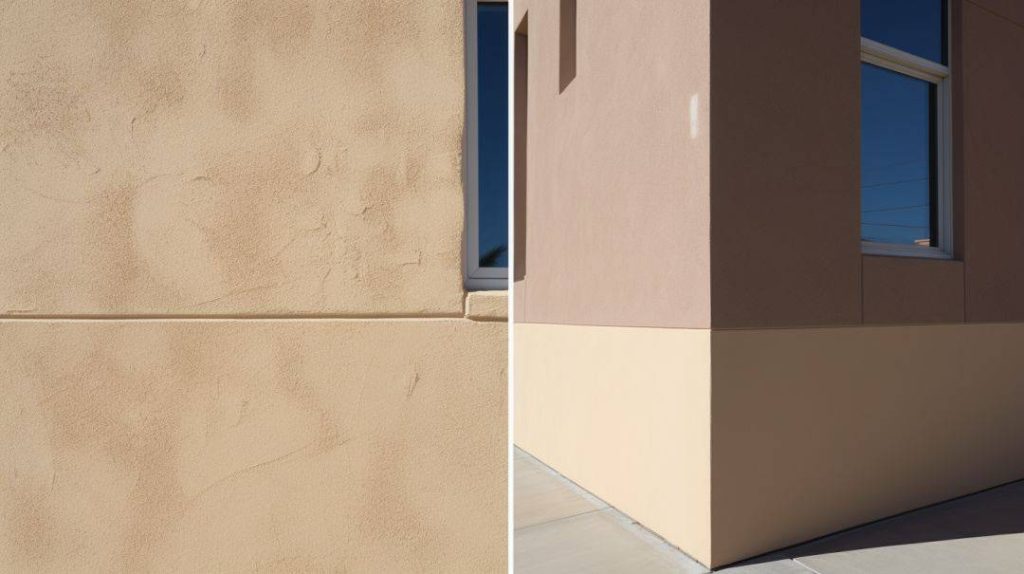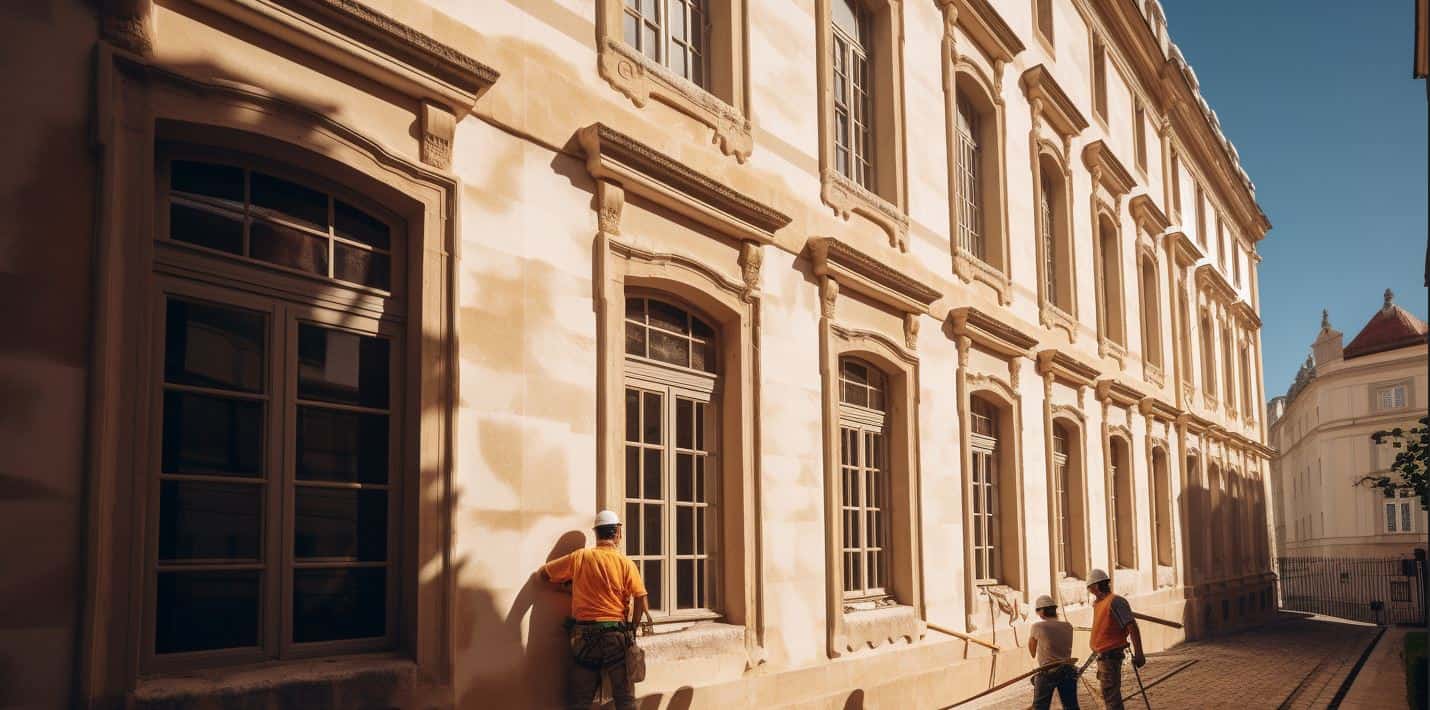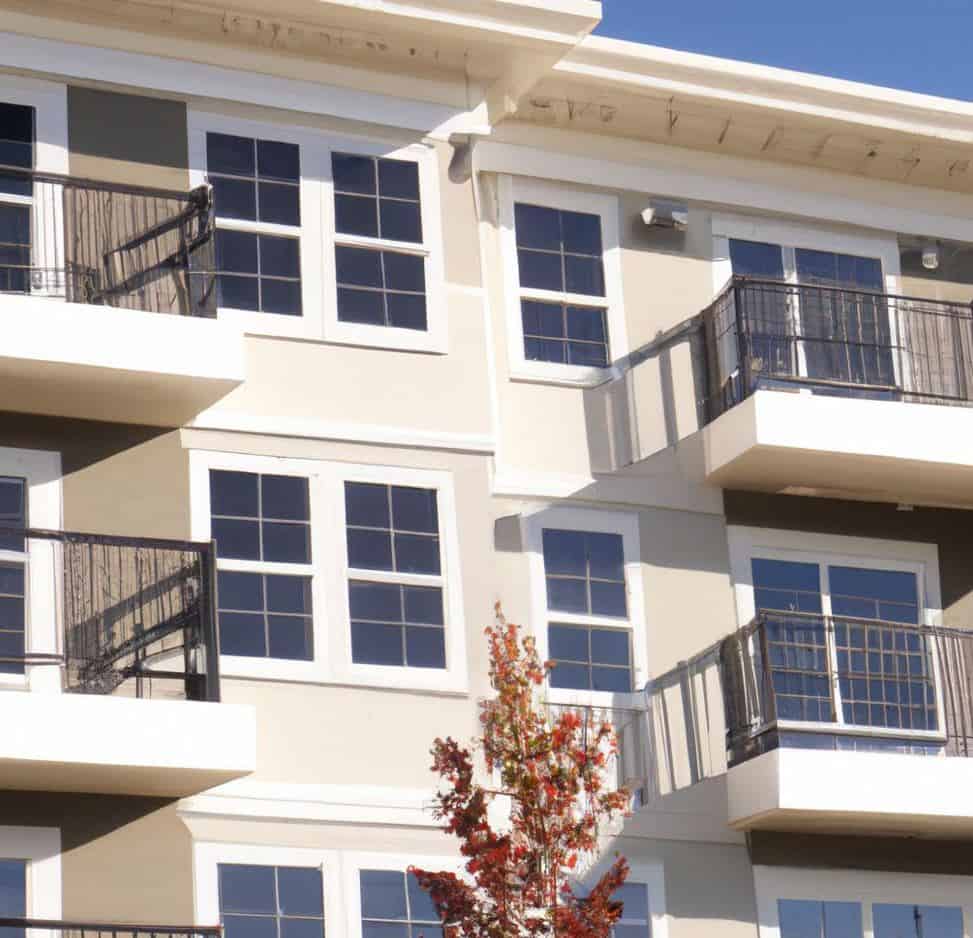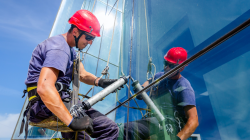Transforming Historic Structures: The Power and Potential of EIFS

Exterior insulation and finish systems (EIFS) have become an increasingly popular option for renovating and preserving historic buildings over the last few decades. Once shunned in the preservation community, new advances in EIFS materials and installation methods have enabled its adaption even for sensitive historic renovation projects.
This article will explore the evolving role of EIFS in historic preservation – from its origins to its benefits and challenges. We’ll look at how EIFS can now be integrated into historic structures while maintaining architectural integrity. Continue reading for insight into this promising niche application of EIFS.
History of EIFS and its Introduction to America
EIFS technology first emerged in post-war Germany as a way to rebuild quickly and affordably. The earliest form of EIFS consisted of foam insulation boards glued onto a building, covered with reinforced mesh and stucco.
This primitive exterior cladding system was brought to America by Dryvit Systems, Inc. in 1969. It was marketed as an alternative to traditional stucco and masonry construction.
Early EIFS was touted for benefits like:
- Energy efficiency from thick insulation.
- Lower construction costs than brick or stone.
- Design flexibility – EIFS could create modern sleek shapes.
By the 1980s, EIFS was being widely used across suburban America for new home construction. It gained popularity for its modern appeal and efficiency.
However, early EIFS systems were plagued by problems like water leakage, damage, and deterioration that would soon surface. Its reputation quickly declined as a result.
The preservation community mainly saw EIFS as an inferior, synthetic substitute for traditional exterior finishes. Using EIFS on historic buildings was frowned upon and seen as incompatible.
But as EIFS technology evolved, it would eventually find a niche even in sensitive historic renovation projects.
EIFS and Compliance with Building Codes
Modern building codes and standards present major challenges for preserving historic structures. Many old buildings fail to meet today’s stringent energy efficiency, weatherization, and ventilation requirements. This can make renovating them difficult and costly.
EIFS provides an attractive path to compliance. The high insulation value and the complete barrier it creates help meet the specific requirements below.
Continuous Insulation and Continuous Air Barrier
Historic buildings often lack continuous insulation (CI) that fully wraps the structure without gaps. They also lack air barriers that prevent drafts and moisture intrusion.
EIFS excels at providing both continuous insulation and an air barrier when installed correctly. The foam insulation boards provide thermal continuity. The reinforced base coat coupled with adhesive layers also produces a superior monolithic air seal around the entire building.
This simultaneously handles two of the most critical modern building performance requirements. EIFS is one of the only practical solutions for adding full CI and air barriers to existing buildings. Utilizing EIFS is often the most cost-effective route to meeting modern energy codes for historic structures.
Energy Conservation
Energy conservation is another key focus of today’s building codes. Minimum energy performance standards are raised with each update of codes like the IECC.
Again, the high insulating value of EIFS dramatically cuts heat loss through exterior walls. This directly reduces the energy consumption needed for heating and cooling.
Thick EIFS insulation also helps compensate for the lack of insulation elsewhere in the building. Entire historic structures can be transformed from drafty energy sieves to highly efficient enclosures.
Certified EIFS installers can provide calculated R-values and estimated energy savings. This documentation helps secure approval during the permitting process. EIFS is the ultimate route for historic structures to meet stringent modern energy codes and performance requirements.
EIFS Components and Types
EIFS is not a single product, but rather a complete system with multiple components. A basic EIFS assembly consists of:
- Insulation boards – Expanded polystyrene or polyisocyanurate foam boards that attach to the substrate.
- Base coat – A fiber-reinforced polymer and cement layer that covers the insulation and embeds the reinforcing mesh.
- Reinforcing mesh – Fiberglass or carbon mesh embedded in the base coat to provide strength.
- Finish coat – The acrylic-based textured outer coat provides aesthetics, weather protection, and color.
Many different types of EIFS exist using various materials and installation methods. Two of the most common EIFS types are:
EIFS vs. ETICS

EIFS refers to traditional EIFS with foam insulation adhered to the substrate. It relies on the base coat and finish for weather protection.
ETICS (External Thermal Insulation Composite Systems) adds insulation over a water-resistive barrier attached to the wall. This provides a drainage plane behind the insulation to handle moisture.
Similarities and Differences

EIFS and ETICS share similarities as multi-layered insulated exterior wall systems. However, ETICS uses more moisture control layers and is better suited for retrofits. EIFS offers greater design flexibility and insulation strength. However, ETICS may make more sense for historic buildings in wet climates.
EIFS and the Secretary of the Interior’s Standards for Treatment of Historic Buildings

An important consideration for any historic preservation project is conforming to the Secretary of the Interior’s guidelines. The Secretary provides guidance and standards aimed at protecting historic integrity during renovations.
Responsibilities of the Secretary of the Interior
The Secretary of the Interior is responsible for establishing best practices for preserving America’s historic buildings and sites. This role includes defining professional standards and principles for renovation work on historic structures.
Key responsibilities include:
- Overseeing the National Register of Historic Places
- Administering grant programs for preservation
- Promulgating standards and guidelines for the treatment of historic properties
Published standards provide a framework for decision-making on appropriate methods and materials for historic renovations.
Establishing Professional Standards
The Secretary of the Interior’s standards are developed in consultation with historic preservation experts. They reflect best practices for retaining historic character during necessary renovations and repairs.
Four distinct standards are defined covering different types of treatments:
- Preservation
- Rehabilitation
- Restoration
- Reconstruction
The rehabilitation standards have the most applicability to integrating EIFS into historic renovation projects. Overall the standards emphasize retention of original fabric along with compatible new elements.
The Growing Use of EIFS in Environmental Investment Projects
Sustainability and energy efficiency have become priorities across the construction industry. This includes finding innovative ways to “green” historic preservation efforts. EIFS is now being utilized to convert old inefficient buildings into environmentally friendly structures.
Providing Capital for Environmental Projects
Major investment capital is being deployed into redevelopment projects focused on environmental performance. Investors are providing financing to transform dated properties into highly efficient and sustainable assets.
EIFS is an attractive option because it drastically reduces energy consumption in outdated buildings. The insulation and air barrier provided by EIFS modifications can cut heating/cooling costs by 35% or more.
Examples of Environmental Projects Using EIFS
One example is the renovation of 425 University Avenue in Toronto, Canada. This historic Victorian structure was retrofitted with a high-performance EIFS facade. Energy use intensity dropped from 328 to just 123 kWh/m2/year – a 62% reduction!
Similar applications of EIFS in historic buildings are being incentivized through property-assessed clean energy (PACE) financing and other green investment programs. EIFS allows old buildings to meet the strict efficiency demands of environmental investors and standards like LEED.
Challenges and Controversies Surrounding EIFS
While EIFS has evolved into an accepted preservation tool, it still faces some challenges and controversies stemming from past issues. These revolve around early failures, legal disputes, and how EIFS was promoted.
Legal Issues
The most pressing controversy was an onslaught of lawsuits in the 1990s over moisture damage in EIFS projects. Faulty installation and design practices resulted in rot, mold, and structural deterioration.
Hundreds of millions in lawsuits were filed against EIFS manufacturers. Strict regulations and training programs have since been implemented to prevent these failures. However, the legal disputes left a stain on the EIFS industry.
Marketing Tactics
Another issue was certain marketing claims made by EIFS manufacturers in the 1980s and 1990s. Aggressive promotion as a low-maintenance, long-lasting finish did not always match the realities of early EIFS systems.
Some developers argue that EIFS was misrepresented as an easier, cheaper cladding requiring little upkeep. The need for rigorous installation and maintenance protocols was downplayed.
These controversies still linger as negatives impacting EIFS’ reputation. But advancements in materials, application techniques, and training have largely addressed the underlying issues. Proper EIFS use can now be a positive for historic preservation.
Adding EIFS to Historic Buildings: Architectural Details

An essential consideration when utilizing EIFS on historic structures is preserving original architectural details. Skillful design and installation techniques allow EIFS to complement and enhance aged architectural features.
Compatible Design and Historical Accuracy
EIFS should never aim to simply mask outdated designs under thick new finishes. The goal is to enhance historic character through compatible updates.
Critical considerations include:
- Maintaining the scale, proportions, and rhythms of original facades. EIFS can follow existing lines versus creating monolithic surfaces.
- Utilizing decorative reveals, trims, and accents in the EIFS finishing to match ornamental details. This preserves a dynamic, authentic look.
- Repairing deteriorated details like decorative brickwork before covering them with EIFS. Damaged or missing elements can be cast and replaced.
- Leaving beautiful aged original finishes like limestone or terra cotta exposed rather than covering up with EIFS.
With thoughtful design, EIFS allows historic integrity and modern functionality to beautifully co-exist.
Maintaining the Integrity of the Original Structure
Equally important is ensuring the original structure remains intact underneath any EIFS modifications. This involves:
- Only applying lightweight EIFS to avoid overburdening fragile old structures.
- Leaving some original finishes exposed for continuity with the building’s past – don’t cover up history.
- Proper prep work like masonry repointing before installation. Attempting to bridge existing deficiencies with EIFS alone leads to failures.
- Correct detailing at transitions, connections, and penetrations to prevent water intrusion issues.
With proper design and installation, EIFS strengthens rather than conceals the original historic structure.
Conclusion: The Evolution of EIFS in Historic Preservation Projects and Its Promising Future
EIFS has come a long way from its early roots as an inexpensive synthetic cladding option. Modern materials and comprehensive quality control programs have enabled EIFS to find a niche in sensitive historic renovation projects.
While not appropriate for every building, EIFS now offers proven performance advantages for many historic structures. The versatility, efficiency, and aesthetics of EIFS facilitate preservation through purposeful renewal and adaptation.
Moving forward, EIFS will continue opening up new possibilities for preserving old structures. With thoughtful design and proper installation, EIFS can help historic buildings meet modern demands while retaining cherished heritage value.
The future looks bright for advanced EIFS applications in historic preservation. EIFS has found its place as one of the most promising technologies for balancing preservation with progress.
If you have a historic preservation project and want to explore how EIFS could provide the perfect building enclosure solution, contact the experts at Indiana Wall Systems. With over 25 years of experience specializing in EIFS and historic restoration, their team has the expertise to meet your unique needs.
Schedule a complimentary project consultation and estimate today by calling (765) 341-6020 or emailing indianawallsystems@yahoo.com. Discover why advanced EIFS is the ideal choice for balancing preservation with performance on your historic renovation. Let Indiana Wall Systems show you how EIFS can help retain heritage while maximizing function and sustainability. Contact them now to get started.
FAQs
Can EIFS be added to a historic home without damaging it?
Yes, modern EIFS materials and proper installation techniques allow it to be integrated into many historic structures without damage. Lightweight insulating panels avoid overburdening fragile buildings. New polymer-based finishes flex and bond well to existing cracked substrates. With proper prep work and design, EIFS complements historic buildings without harming them.
Does EIFS alter the appearance of old historic architecture?
Not if designed and installed correctly. EIFS can follow original lines, textures and details to maintain authentic facade appearances. Decorative trim pieces can match existing ornamentation. Aged finishes like stone or brick can remain exposed rather than covering them up. The goal is enhancing, not concealing, historic designs.
Can moisture issues occur with EIFS on old buildings?
Past moisture problems stemmed mainly from poor application practices, not inherent flaws in EIFS technology. With rigorous installer training, strict specifications, and regular maintenance, modern EIFS performs very well. Added barriers like water-resistive coatings provide extra protection on historic structures.
Does EIFS meet Secretary of Interior standards for historic buildings?
In many applications, yes. The Secretary’s rehabilitation standards emphasize retention of historic fabric along with compatible new features. Properly designed EIFS fits within these guidelines by maintaining original appearances while improving performance. EIFS is not appropriate for every historic property, however.
Is EIFS the only option for improving energy efficiency in old buildings?
No. Solutions like interior insulation also exist. But EIFS is unmatched in affordably providing a complete thermal barrier and air seal. This allows historic buildings to meet modern energy codes they likely couldn’t otherwise. Added insulation elsewhere in the building envelope can supplement EIFS wall upgrades.




